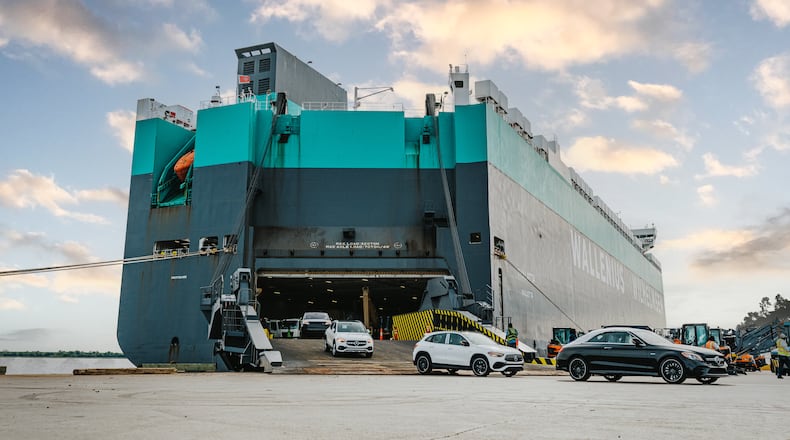JEKYLL ISLAND — The Port of Brunswick has been stalking Baltimore for the title of America’s busiest port for automobiles and heavy equipment for the last two decades, moving from fifth to second over that span and on pace to overtake the rival port in 2026.
Brunswick’s closing kick proved faster than that.
The marine terminal along the Georgia coast in 2024 became the nation’s leading port for wheeled and tracked cargo, known in the industry as roll-on, roll-off — or RORO — cargo. Brunswick’s Colonel’s Island facility handled 2.1 million tons of cars, tractors, bulldozers and other farm and construction equipment compared to 1.6 million in Baltimore.
Georgia Ports Authority CEO Griff Lynch shared the performance numbers Wednesday during the annual Brunswick State of the Ports event at the Jekyll Island Convention Center. He compared Brunswick to horse racing champion Secretariat, a racehorse that displayed unprecedented closing speed.
“We are going to keep accelerating,” Lynch said. “We are going to keep doing what we do well. In five years, I want us to look over our shoulder and not see any competition.”
Credit: Courtesy of Georgia Ports Authority
Credit: Courtesy of Georgia Ports Authority
Brunswick’s hold on the top spot is likely to last. Baltimore recorded growth even as it fell behind Brunswick — and in spite of a 78-day closure forced by the deadly collapse of the Francis Scott Key Bridge in March. A container ship leaving the Baltimore port lost power and drifted into a bridge support, causing the 8,000-foot-long span to fall into the Patapsco River, killing six construction workers doing maintenance on the bridge. The wreckage blocked the shipping channel.
Brunswick captured a marginal amount of Baltimore-bound auto imports during the closure — estimates range from 3,000 units to 10,000 units — but much of the Georgia port’s growth was organic. Expansion of auto processing facilities as well as a heavy equipment storage yard on the Brunswick terminal allowed for more capacity, which shippers put to use.
Baltimore faces greater space constraints than Brunswick. And with population patterns shifting south, more manufacturers are investing in Brunswick. Eighteen automakers do business in Brunswick through four on-terminal auto processing facilities.
“Our success has a lot to do with the strategic location of the port,” said Don Asdell, CEO of one of those tenants, International Auto Processing.
Brunswick handled 841,000 auto units in 2024, an 18% increase over 2023. The port also loaded or unloaded about 29,000 pieces of heavy machinery, a 160% gain.
Credit: Courtesy of the Georgia Ports Authority
Credit: Courtesy of the Georgia Ports Authority
The Port of Brunswick and other ports authority facilities support 561,000 jobs and contribute $59 billion annually to the state’s gross domestic product, a study by the University of Georgia showed.
Brunswick is one of two coastal seaports in the Georgia Ports Authority. Brunswick handles automobiles, heavy equipment and other wheeled vehicles along with breakbulk cargo, or goods too large to fit into shipping containers. The Port of Savannah is GPA’s container port and ranks as the third-busiest in the country.
Lynch on Wednesday outlined new investments to further power Brunswick’s lead, including the construction of a fourth ship berth to be completed in 2027 and a $100 million expansion of the on-terminal rail infrastructure. The port will soon begin to lay new tracks to connect all portions of the terminal and build a new rail yard on the end opposite the existing rail loading and unloading area.
The project will nearly quadruple the capacity for rail movements annually from about 160,000 vehicles currently to 590,000 by 2030. The rail improvements are similar to what the ports authority did in Savannah with the Mason Mega Rail, which opened in 2021 and doubled the number of containers that could be moved off-terminal via train.
“You could call this Mega Rail 2.0, but it’s our customers who are saying to do this because they see more exports coming our way,” Lynch said. “We are responding to their call.”
Imports make up the overwhelming majority of autos moving through the Brunswick port currently. But exports are forecast to grow, and most of the automaker plants in the U.S. are in the South and Midwest. Hyundai recently opened a factory near Savannah, and while the Korea-based company projects much of the early production vehicles from the site will be sold domestically, the automaker is a client in Brunswick.
About the Author
Keep Reading
The Latest
Featured




